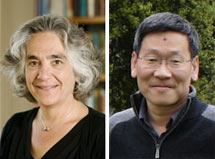

Friday - June 25, 2010
SLAC Today is
available online at:
http://today.slac.stanford.edu
In this issue:
From the Director: ZX Shen Becomes Chief Scientist for SLAC
Call for Applications: Ashley Fellowship
Word of the Week: Activation
 |
 |
|
Friday - June 25, 2010 |
From the Director: ZX Shen Becomes Chief Scientist for SLAC (Photos by Linda Cicero and Kelen Tuttle.)
Leading SLAC for nearly three years now has been an exciting challenge for me. In the early part of my tenure as director, the operational side of the laboratory took an enormous amount of my attention. Since January of this year (see my first column of this year) I have been focusing much more on the development of the science portfolio at SLAC. In particular I have focused on building up the performing science—the science we at SLAC do—as opposed to the science we enable others to do with our outstanding user facilities. I have relied heavily on the associate laboratory directors in the mission areas of the laboratory in this process, and they do a very good job of not only working for the benefit of their directorates, but taking a lab-wide view of our science activities. However, I have felt that we lacked someone at the management level of the laboratory to help integrate and optimize across SLAC's science portfolio, particularly in the areas of basic energy sciences, energy and the science enabled by our X-ray facilities. Read more... Call for Applications: Ashley FellowshipSLAC is now accepting applications for the 2010-11 Alonzo W. Ashley Fellowship. The fellowship is a one-year job rotation and on-the-job training opportunity accompanied by time off to attend related coursework. The Ashley Fellowship was created in honor of Al Ashley, who retired from SLAC after 30 years of dedicated and exemplary service, particularly in the area of diversity in the sciences and engineering. During his tenure at SLAC, Ashley pioneered programs that promoted workplace diversity and encouraged career development for employees and career exploration for talented students. This year, the fellowship is open to both in-house candidates with at least three years of full-time experience at SLAC and outside candidates who are recent college graduates in a scientific or engineering field. A successful candidate for the Ashley Fellowship is one who can align his or her career objectives to the current scientific effort at SLAC, and who is committed to promoting and exemplifying the importance of diversity in science and engineering. Eligibility information, requirements and application instructions are available in the Alonzo Ashley Fellowship Web page. Word of the Week: Activation An artist's conception of the Fermi Gamma-ray Space
Telescope. (Image: NASA.)
In space instrument parlance, activation refers to the detailed sequence of commissioning and checkout procedures needed to verify that a spacecraft and its instruments are working as intended after launch. Two years ago today, the Large Area Telescope onboard the Fermi Gamma-ray Space Telescope spacecraft successfully completed activation. In the LAT's case, activation included methodically turning on and configuring each of the instrument's many sub-systems, from power supplies and detector elements to onboard data processing computers, and verifying at each step that the hardware and software were working as expected. LAT team members working at the Mission Operations Center in the Goddard Space Flight Center carefully executed the command sequences and inspected data returned by the instrument—from basic voltages, currents and temperatures to detailed message streams from the instrument's flight software. Teams of scientists at the LAT Instrument Science Operations Center at SLAC followed up with thorough inspection of the science data, looking for the characteristic signatures of gamma rays collected by the telescope. LAT activation began at 10:59 UT on June 24, 2008. Thanks to a well-built and exhaustively tested instrument, a seasoned team that had practiced the procedures many times, and strong support from spacecraft controllers at Goddard, the process took just under 24 hours. By 10:57 UT on June 25, 2008, the LAT was up and taking its very first data. Read more... |
Events
Access (see all)
Announcements
|
|
| | ||
|
|
||
 <%
Response.AddHeader "Last-modified", getArticleDate()
'Response.AddHeader "Last-modified","Mon, 01 Sep 1997 01:03:33 GMT"
'Monday, December 06, 2010
%>
<%
Response.AddHeader "Last-modified", getArticleDate()
'Response.AddHeader "Last-modified","Mon, 01 Sep 1997 01:03:33 GMT"
'Monday, December 06, 2010
%>View online at http://today.slac.stanford.edu/. |
||